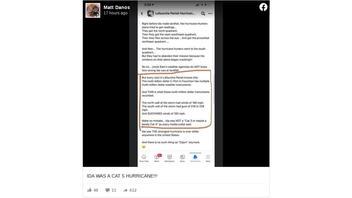
Did the hurricane hunters of the Air Force Reserve "abandon their mission" because their aircraft suffered cracked windows while chasing Hurricane Ida in late August 2021? No, that's not true: An aircraft used by the hurricane hunters had a single "spider" crack in its windshield on August 28, 2021, a day before Hurricane Ida made landfall in Louisiana. According to Air Force Reserve Capt. Will Simmons, who was on that aircraft, the crew cut short their August 28, 2021, mission once they noticed the crack. The window pane was replaced and the crew were able to go out again on August 29, 2021, when they passed through the eye of the hurricane twice with no issues.
The story appeared in a Facebook post (archived here) on September 14, 2021. The part this fact check is debunking reads:
And then... The hurricane hunters went to the south quadrant... But they had to abandon their mission because the windows on their plane began cracking!!!
This is what the post looked like on Facebook at the time of writing:
(Source: Facebook screenshot taken on Wed Sep 15 17:16:42 2021 UTC)
The 53rd Weather Reconnaissance Squadron, or the hurricane hunters of the Air Force Reserve, is part of the Department of Defense. Based at Keesler Air Force Base in Biloxi, Mississippi, they have been flying into hurricanes and tropical storms since 1944.
They fly a fleet of 10 WC-130J Hercules aircraft when researching hurricanes.
A spokesperson for the hurricane hunters told Lead Stories what happened on August 29, 2021:
Regarding the August 29 mission right as the storm was making landfall, the mission the post refers to, there were no maintenance issues (window cracks included) or data fix shortcomings on that flight. The crew was able to make two passes through the eye before it moved onto land. Once the center of a system is over land, the crews don't fly through it both for flight safety reasons and because at that point there are generally instruments on the ground that can measure the conditions of the eye. .. But to serve your fact checking purpose, as it relates to us and that post, that post is inaccurate.
Asked why the windshield had cracked, the spokesperson said there could have been a number of reasons but that wind speed was not one of them. The aircraft's maximum speed is 427 mph.
In both a broadcast news interview, in which Simmons recounted the moments during and after the the spider crack, and in an article, in which the flight's navigator, Lt. Col. Mark Withee, said the crack did not put the crew in danger, it's clear only one window was cracked, not multiple windows, as the post claims.
And then as we were flying along, our window started to crack, kinda spider within a few seconds ... But there are actually two pieces of glass on that window, so just the outer pane that began to crack ... So of course, anything like that, something that's out of the ordinary, we do take that very seriously. Safety definitely comes first. So the first thing we did, we were already in stable, smooth conditions as the pilot flying kept flying the aircraft, we got in our checklist, we got procedures for that, we train regularly to go through those kind of malfunctions, so for us we just followed our checklist and called air traffic control and coordinated a plan to return back to the base that we were going to.
The Facebook post's claim that Hurricane Ida got up to 228 mph with sustained winds of 192 mph is also not accurate, according to sources including the National Hurricane Center. A tropical Atlantic link the spokesperson provided Lead Stories says Ida's winds did not get above 183 mph. Tropical Atlantic is a non-governmental weather content and tracking service.
According to the National Oceanic and Atmospheric Administration and the National Hurricane Center, Ida's maximum sustained winds at landfall on August 29, 2021, were estimated to be at 150 mph.















